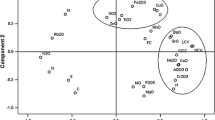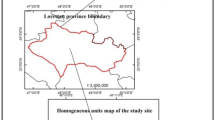Abstract
Trees of the 56-year old oak stand, including those having dry crown and lacking desiccation features, have been tested biochemically. Neighboring 200to 300-year-old trees lacking drying crown features served as the control. We focused the study on protein contents in leaves and chose flavonols and tannins out of secondary metabolites. The higher activity of dominant pests Altica quercetorium and Erannis defoliaris in the stand has been shown to be related to lower proteins and condensed tannins concentration when compared with old trees.
Similar content being viewed by others
References
Belikov, V.V., Analysis of the content of flavonol derivatives in fruits of Silybum marianum (L.) Gaerth., Rastit. Resur., 1985, no. 3, pp. 350–358.
Buzun, G.A., Dzhemukhadze, K.M., and Mileshko, L.F., Determination of protein in the plants using amido black dye, Fiziol. Rastit., 1982, vol. 29, pp. 350–358.
Polyakova, L.V., Relationship of biochemical features as an indicator of resistance of natural populations of the English oak, Lisov. Zh., 2011, no. 31, pp. 12–15.
Polyakova, L.V., Gamayunova, S.G., and Zhurova, P.T., Comparative biochemical analysis of the century trees and 55-year culture of the English oak growing in Svyatye Gory National Nature Park, Lisivnits. Agrolesomeliorats., 2012, vol. 121, pp. 78–83.
Polyakova, L.V. and Zhurova, P.T., Phenolic compounds of the leaves of maternal trees and seedlings of half-sib progeny of the English oak, Biol. Vestn., 2007, vol. 11, no. 2, pp. 61–66.
Selochnik, N.N. and Kaplina, N.F., Analysis of the status of oak forests taking to account the tree crown development in unfavorable conditions: anthropogenic (Moscow oblast) and climatic (forest-steppe), Vestn. Mosk. Gos. Univ. Lesa–Lesn. Vestn., 2011, no. 4 (80), pp. 103–108.
Butler, L., Bandyopahyay, R., and Mughogho, L., Polyphenol concentration in grain, leaf and callus tissues of moldsusceptible and mold-resistant Sorghum cultivars, J. Agric. Food Chem., 1986, vol. 34, pp. 425–429.
Forkner, R. and Marquis, R., Uneven-aged logging alter foliar phenolics of oak trees remaining in forested habitat matrix, For. Ecol. Manage., 2001, vol. 199, pp. 21–37.
Haley, S.L., Lamb, J.G., Franklin, M.R., Constance, J.E., and Dearing, D., Xenobiotic metabolism of plant secondary compounds in oak (Quercus agrifolia) by specialist and generalist woodrat, J. Chem. Ecol., 2007, vol. 33, no. 11, pp. 2111–2122.
Julkunen-Tiitto, R., Phenolic constituents in leaves of northern willows: methods for the analysis of certain phenolics, J. Agric. Food Chem., 1985, vol. 33, pp. 213–217.
Kitamura, M., Nakamura, T., Hattoti, K., Ishida, T., Shibata, S., Sato, H., and Kimura, M., Among-tree variation in leaf traits and herbivore attacks in deciduous oak Quercus dentata, Scand. J. For. Res., 2007, vol. 22, pp. 211–218.
Le Corff, J. and Marcus, R., Canopy-understory differences in Missouri oak herbivore communities, Ecol. Entomol., 1999, vol. 24, pp. 46–58.
Lill, J. and Marques, R., The effects of leaf quality on herbivore performance and attack from natural enemies, Oecologia, 2001, vol. 126, pp. 23–29.
Ossypov, V., Haukioja, E., Ossypova, S., Hanhimaki, S., and Pihlaja, K., Phenolic-related factors as determinants of suitability of mountain birch leaves to an herbivorous insect, Biochem. Syst. Ecol., 2001, vol. 29, pp. 223–240.
Salminen, J.-P., Roslin, T., Karonen, M., Sinkkonen, J., Pinlaja, K., and Pulkkinen, P., Seasonal variation in the content of hydrolizable tannins, flavonoid glycosides, and proanthocyanidins in oak leaves, J. Chem. Ecol., 2004, vol. 30, no. 9, pp. 1693–17002.
Author information
Authors and Affiliations
Corresponding author
Additional information
Original Russian Text © L.V. Polyakova, S.G. Gamayunova, P.T. Zhurova, V.I. Litvinenko, 2014, published in Lesovedenie, 2014, No. 4, pp. 28–35.
Rights and permissions
About this article
Cite this article
Polyakova, L.V., Gamayunova, S.G., Zhurova, P.T. et al. Biochemical specifics of English oak trees with dry crown. Contemp. Probl. Ecol. 8, 885–891 (2015). https://doi.org/10.1134/S1995425515070100
Received:
Published:
Issue Date:
DOI: https://doi.org/10.1134/S1995425515070100




